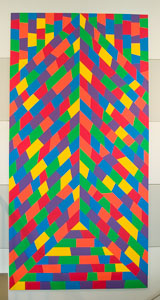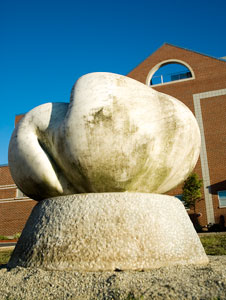  |
| HOME | THIS ISSUE | CALENDAR | PATENTS | BACK ISSUES | < BACK | NEXT > |
Works of art in public spaces beautify University’s campusesby Sherry Fisher - October 3, 2005 |
||||||
|
A copper and concrete obelisk stands nearly 43 feet tall outside von der Mehden Recital Hall. A 36 foot-long mobile of Lexan and stainless steel sways gently as it hangs from the ceiling of the Babbidge Library’s north entrance pavilion. A bronze sculpture of a family gathered in a circle, some 15 feet high, greets visitors outside the main hospital entrance of the UConn Health Center.
These artworks, created by Jackie Ferrara, Tim Prentice, and Wolfgang Behl, respectively, are among some 80 pieces by international and local artists that grace the public spaces at the University of Connecticut. Thousands pass them as they hurry to class or admire them from afar during a stroll outside, but these sculptures, paintings, drawings, stained glass, and ceramic pieces are worth a closer look. Thanks to a new pocket-size guide that will be available at the end of the semester, people will be able to do just that. The guides will be on hand at all UConn campuses and at visitors centers throughout the state. A public arts website is also being created. The guide includes a listing of public artworks on all campuses, maps of their locations, walking tours, photographs, descriptions of the works, and information about the artists. This is the first time that art in public spaces on UConn campuses has been documented in a guide. “Art breathes life into the campus,” says David Woods, dean of the School of Fine Arts, who chairs the committee. “It educates and enriches the lives of the University community and campus visitors and beautifies it as well. It’s up to us to give as much information about art as we can. Information generates understanding, and that leads to appreciation.” In 2002, University President Philip E. Austin charged the University’s Public Arts Committee with developing guidelines and ideas for campus art – located both inside and outside – to bring consistency to the artistic environment on campus. The committee’s main objectives were to review the art currently on campus; to review and advise on all proposed art projects; and to guide the treatment of space for the entire campus arts environment. The committee is in the process of finalizing a master plan for the arts. Woods says public artwork should reflect and connect to the space in which it is placed, and be compatible with existing artworks. The master plan includes the development of artistic neighborhoods. A section of campus would be designated as a neighborhood for human rights art, for example.
The majority of works purchased were funded by the State of Connecticut’s Percent-for-Arts Program – whereby a percentage of the construction budget for any new public building is set aside for the purchase or commissioning of artwork – and facilitated by the state Commission Culture and Tourism. Other works have been donated. Woods says one of the committee’s functions is to have dedications for new artwork. Receptions are held and artists are invited to speak to students and give public lectures. “I host the artist with the dean of the college or school where the artwork will be placed,” Woods says. “It has been a wonderful opportunity.” One of the newest acquisitions is a sculpture made of Carrara marble by Richard Graham, an American artist who has lived in France for the past decade. The 3-by-4 foot, 3,000 pound piece is located behind the Nafe Katter Theatre. The work blends the geometric and organic, with an emphasis on simple bold shapes. Woods says he hopes the guide will “encourage people from throughout the state to come to our campuses and view the artwork.” |
| ADVANCE HOME UCONN HOME |


